Connecticut, known for its quaint villages, scenic vistas, and historical significance, also hosts a creature that evokes unease in numerous individuals: the black spider. These eight-legged arachnids are distinguished by their dark hue, unique patterns, and occasionally venomous bites. While some may appreciate their role in controlling insect populations, others may feel uneasy sharing their space with these creepy crawlers.
Whether you encounter them in your backyard or in the depths of the wilderness, black spiders in Connecticut are a fascinating and sometimes intimidating part of the state’s natural world. Without further ado, let’s dive into the world of these mysterious black spiders in Connecticut!
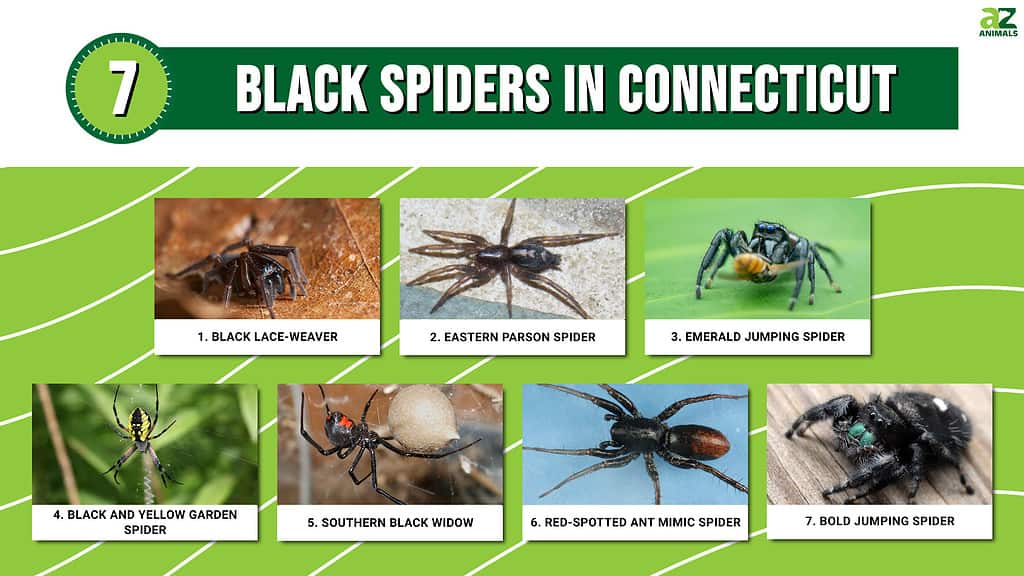
1. Black Lace-Weaver (Amaurobius ferox)

The black lace-weaver spider features dark shades of black, brown, dark red, and tan.
©Federico.Crovetto/Shutterstock.com
Originating from Europe, the black lace-weaver spider has established a presence in Connecticut.
These spiders exhibit a distinct appearance, featuring dark shades of black, brown, dark red, and tan. Their rounded abdomen displays pale yellow patterns reminiscent of a ghostly mask or skull. As with numerous other spider species, the black lace-weaver displays sexual dimorphism, with females being larger than males. In general, females have a body length of 0.4 to 0.6 inches, while males measure up to 0.4 inches.
Primarily feeding on insects, the black lace-weaver can be found in various locations, such as basements, dwellings, and gardens.
The black lace-weaver constructs a unique cribellate web using a special woolly silk to trap prey and ensure protection. The silk consists of extremely fine, adhesive fibers, which has led to the spider’s common name, the black lace-weaver.
Fascinatingly, female black lace-weavers not only supply food to their young but also willingly offer their own bodies to be consumed.
While these spiders play a beneficial role in controlling pests, they have been known to bite humans on occasion. In a confirmed case, an individual reported experiencing mild discomfort akin to a wasp sting after being bitten by a black lace-weaver.
2. Eastern Parson Spider (Herpyllus ecclesiasticus)

The eastern parson spider is commonly found in Connecticut and is known for being aggressive in nature.
©Fyn Kynd from Searsmont, Maine, United States / CC BY 2.0, via Wikimedia Commons – Original / License
A member of the ground spider family, the eastern parson spider is a common sight in the state of Connecticut.
The body of the eastern parson spider is covered with gray hairs on the abdomen and black hairs on the cephalothorax. The common name of the species is derived from the white mark on its back, along with a small white spot above its spinnerets. The eastern parson spider typically ranges from 0.4 to 0.8 inches in size when fully grown.
The eastern parson spider is a hunter spider that doesn’t spin a web to capture prey. Instead, it spends the day hiding and actively searches for smaller insects to prey on at night. It is a quick-moving spider and has an aggressive nature. The spider’s silk glands are only used to produce an egg sac for offspring.
This spider is typically found on the ground under stones and logs in deciduous forests and woodlands. Occasionally, the eastern parson spider may invade homes in search of prey and may take refuge in clothes.
In situations where the spider feels trapped, it may bite without hesitation. A bite from the eastern parson spider is usually very painful and can trigger allergic reactions in susceptible individuals. Nonetheless, this species is not medically significant, and the initial pain typically subsides quickly. But if you are bitten and you experience severe symptoms, such as difficulty breathing or chest pain, seek medical attention immediately.
3. Emerald Jumping Spider (Paraphidippus aurantius)
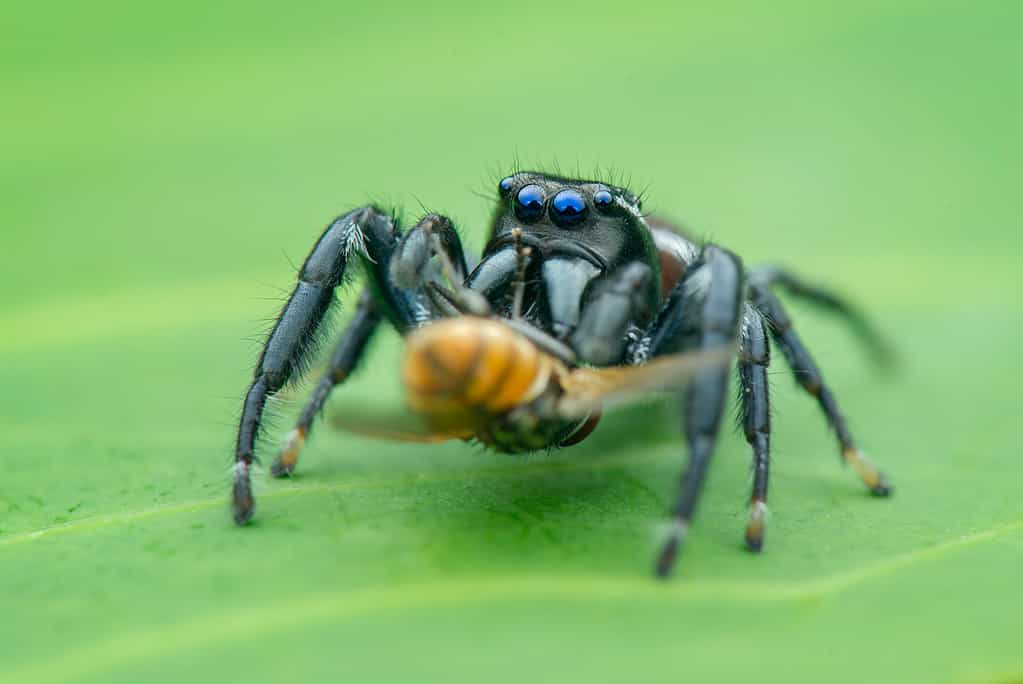
Male emerald jumping spiders are black with white markings while females are brown with hints of orange.
©DWI YULIANTO/Shutterstock.com
Paraphidippus aurantius, a type of jumping spider, is commonly referred to as the emerald jumping spider in Connecticut.
Recognizing this particular jumping spider species is simple due to its distinct green markings, small size, and strong legs. Males of the emerald jumping spider are black with a white stripe on either side of their head, while a white edge traces the upper part of their abdomen. Females exhibit brown coloration with hints of orange.
Female spiders measure around 0.12 inches, with males being slightly smaller.
As solitary predators, emerald jumping spiders are highly capable of surviving independently in the wild. These spiders carefully watch, track, and ambush their prey, utilizing their impressive jumping abilities. Their diet includes insects, such as flies, crickets, aphids, and ants.
Though they aggressively pursue their prey, emerald jumping spiders are generally timid around humans. Their amicable nature and captivating appearance make them a popular choice among exotic pet enthusiasts.
Emerald jumping spiders can be found in both rural and suburban forested areas, with sightings most common during the fall months.
Their venom is not harmful to humans, and a bite will only cause minor irritation and redness.
4. Black and Yellow Garden Spider (Argiope aurantia)

The black and yellow garden spider is the largest among the orb weavers in Connecticut often reaching 1 inch in length.
©Ron Rowan Photography/Shutterstock.com
A member of the orb weaver family, the black and yellow garden spider can be found in tall grasslands in Connecticut. Among all orb weavers in Connecticut, female black and yellow garden spiders are the largest, with body sizes ranging from 0.75 to just over 1 inch in length. Males, on the other hand, are much smaller, generally measuring between 0.2 to 0.35 inches in length.
Female black and yellow garden spiders are characterized by silver hairs at the tip of their cephalothorax and a yellow and black pattern on their abdomen. Meanwhile, males have a cross-like appearance, as they tend to hold their front and hind legs together.
These spiders detect their prey by sensing vibrations in their webs, which are made of sticky strands. They feed on anything that gets caught in their webs. Black and yellow garden spiders typically build their webs in gardens, grassy areas near homes, and tall grasslands.
At times, the webs spun by black and yellow garden spiders can measure up to 2 feet in diameter! During the night, the spiders will consume parts of their webs, along with any materials, such as plant pollen, that might have gotten stuck on them.
Generally active during the day, black and yellow garden spiders will bounce up and down on their web to make it vibrate when a larger organism gets too close.
These spiders lay a silken cocoon that is almost 1 inch in diameter in the fall after mating, where the young develop and hatch in the spring.
Humans are rarely bitten by black and yellow garden spiders, and their venom is not medically significant. If they become bothersome, however, gently removing or destroying their webs can prompt them to relocate.
5. Southern Black Widow (Latrodectus mactans)
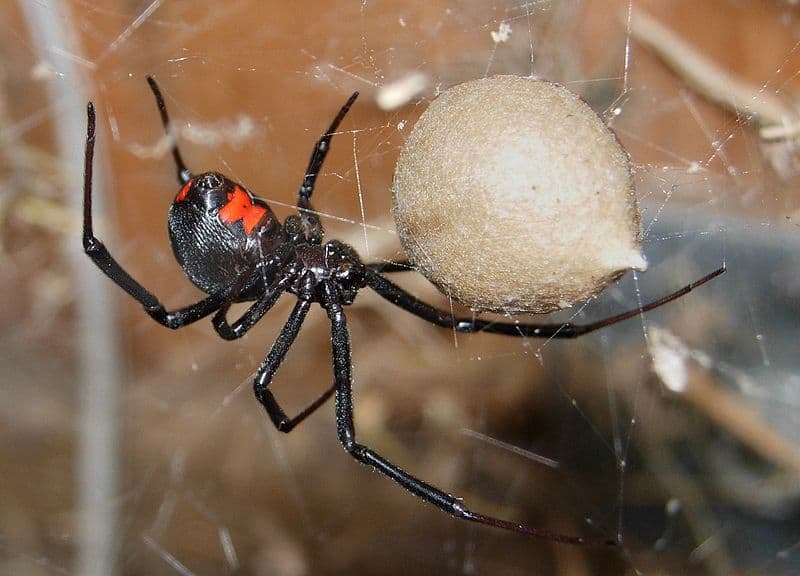
The southern black widow can identified by its distinctive red hourglass pattern.
©Chuck Evans(mcevan)”./ CC BY 2.5, via Wikimedia Commons – Original / License
With a higher prevalence in human settlements, the notorious southern black widow spider can thrive both indoors and outdoors. In Connecticut, both the southern and northern black widow species can be found.
Identifying the southern black widow is easy as it is a shiny black spider with a round abdomen. The upper side of the abdomen is always entirely black, while the underside has a distinct red hourglass pattern. The body length of the female is approximately 3/8 inch, and the male is around 3/16 inch. However, the size may vary across different regions.
Black widows feed on a variety of flying and crawling insects, including flies, grasshoppers, and other spiders. They usually construct webs in woodpiles, debris piles, beneath rocks, in hollow tree trunks, and inside rodent burrows. But these spiders can also be found in human settlements, such as garages, sheds, and other dark, sheltered areas.
After mating, females typically kill and eat males, which gives this terrifying spider its name.
Adult female southern black widow spiders are mainly responsible for the fearsome black widow bites, as immature and male black widows lack fangs large enough to penetrate human skin. Bites typically occur when female spiders feel threatened and need to defend their egg sacs. Reactions to the bites can vary from localized symptoms to severe systemic responses.
Symptoms may include painful swelling around the bite area, cramps, muscle spasms, and general discomfort. Medical attention is advised if bitten or if you suspect to have been bitten by a southern black widow.
While black widow bites can be highly unpleasant, contrary to popular belief, fatalities resulting from these bites are relatively uncommon.
6. Red-Spotted Ant Mimic Spider (Castianeira descripta)
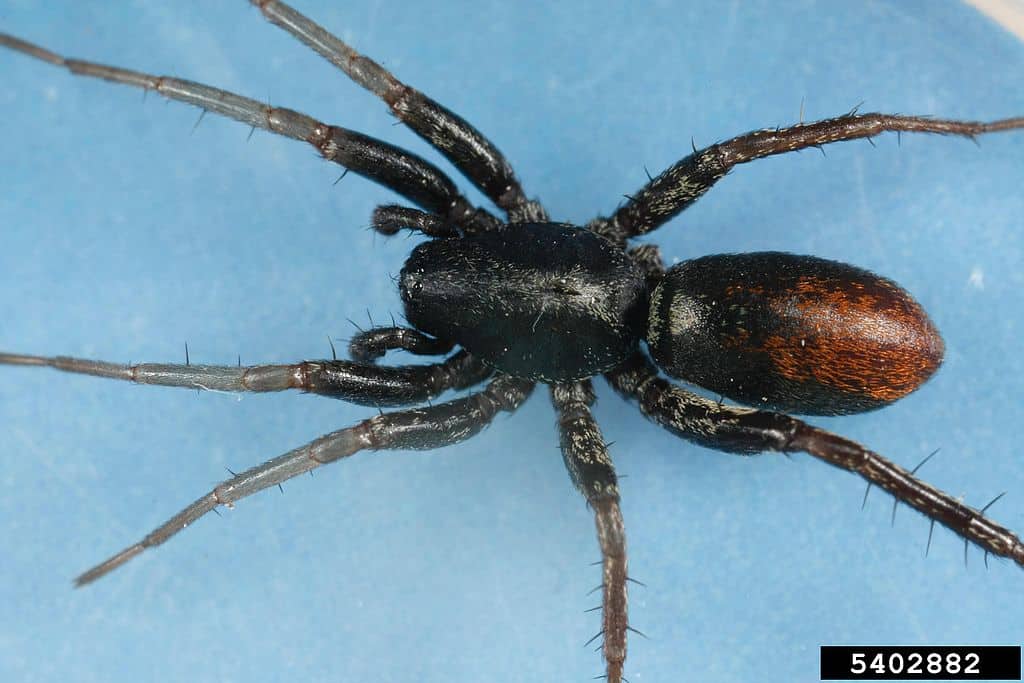
The red-spotted ant mimic spider moves like an ant to deceive its prey.
©Joseph Berger, Bugwood.org; University of Georgia / CC BY 3.0, via Wikimedia Commons – Original / License
One of the most clever spider species, the red-spotted ant mimic spider has a distinctive appearance. It is mostly black with vibrant red markings and a white stripe that runs down its back. When moving around, this spider uses a clever tactic to deceive its prey, holding its front legs up while walking on the other three, making it appear like an ant. This mimicry strategy helps the spider capture ants and other insects that it preys on, as ants are typically quick and agile and would be difficult for the spider to catch without some form of deception.
This species typically inhabits shrubs, woods, and parks and can be found under rocks. Its diet consists of small insects and ants, which it hunts without the use of webs. The female red-spotted ant mimic spider can grow up to half an inch, while the males are smaller.
The red-spotted ant mimic spider is typically not a danger to humans or pets, as it usually feeds on small insects and ants. Despite being capable of aggression, it does not pose a significant threat. If bitten, individuals may experience redness and swelling similar to a bee sting. It is essential for those with allergies to take extra precautions.
7. Bold Jumping Spider (Phidippus audax)
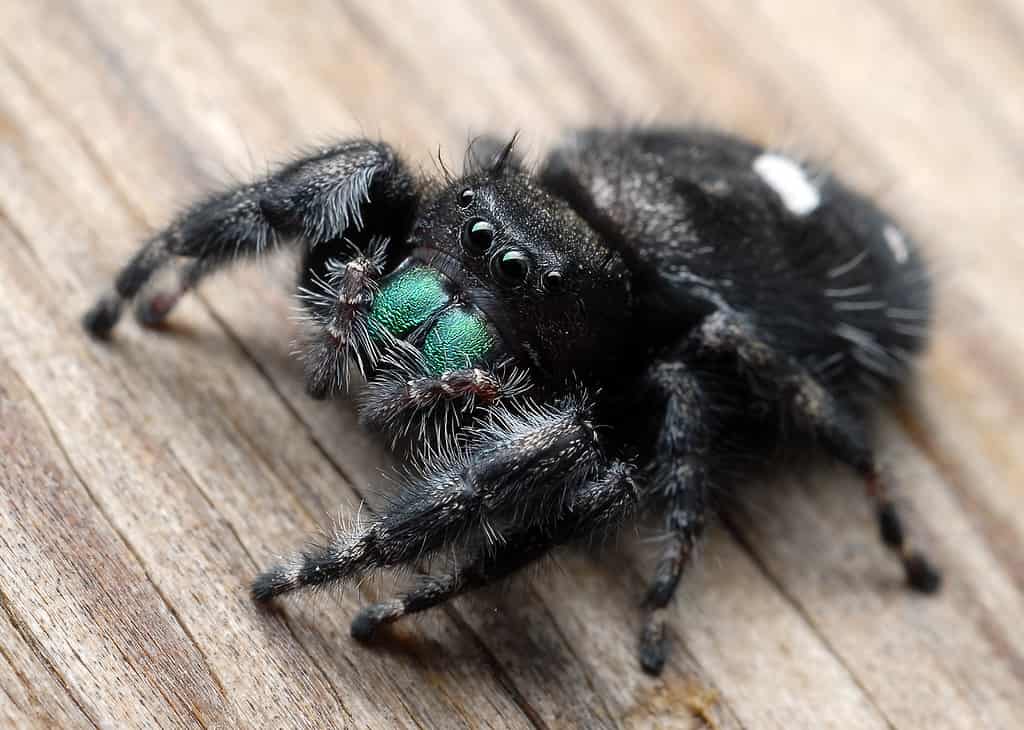
The bold jumping spider is capable of jumping 50 times its body length.
©Miles Boyer/Shutterstock.com
The bold jumping spider, also known as the daring jumping spider, is a common and active spider species found in Connecticut. These spiders are characterized by their boldness and agility, and they are capable of jumping up to 50 times their own body length!
Adult bold jumping spiders are typically black and hairy and measure between 0.5 to 0.8 inches in length. They have distinctive white, yellow, or orange spots on their abdomens, with younger spiders having orange spots. Additionally, their chelicerae have an iridescent green hue.
Male bold jumpers have tufts of hair over their eyes that resemble eyebrows, and they may have white bands extending back from their rear eyes. In addition, the spiders have a set of large central eyes on their cephalothorax that are essential for capturing prey.
Bold jumping spiders are versatile creatures that are known for their ability to thrive in different terrestrial habitats such as open woodlands, chaparrals, grasslands, and agricultural fields.
They have a preference for temperate climates and are recognized for their resilience in adapting to various environments. These spiders feed on a wide range of insects and non-insect arthropods, including other spiders, grasshoppers, dragonflies, and caterpillars. They play a crucial role in their ecosystem by keeping insect populations under control.
Being one of the most commonly occurring spider species within their range, bold jumping spiders are frequently found living in close proximity to humans.
Although these spiders are shy and tend to retreat from humans when approached, they may bite if handled. Their bites usually cause minor pain, itching, swelling, and redness that may last for one to two days. However, if you come across one, given their role in controlling insect populations, it’s worth considering leaving them be rather than getting rid of them.
Summary of 7 Black Spiders in Connecticut
Here’s a recap of the seven spiders with black colorations we looked at that can be found in Connecticut.
| Number | Spider | Scientific Name | Body Length Size |
|---|---|---|---|
| 1 | Black Lace-Weaver | Amaurobius ferox | Females: 0.4 to 0.6 inches; males: up to 0.4 inches |
| 2 | Eastern Parson Spider | Herpyllus ecclesiasticus | 0.4 to 0.8 inches |
| 3 | Emerald Jumping Spider | Paraphidippus aurantius | Females: around 0.12 inches; males are slightly smaller |
| 4 | Black and Yellow Garden Spider | Argiope aurantia | Females: 0.75 to over 1 inch; males: 0.2 to 0.35 inches |
| 5 | Southern Black Widow | Latrodectus mactans | Females: 3/8 inch; males: 3/16 inch |
| 6 | Red-Spotted Ant Mimic Spider | Castianeira descripta | Females can grow up to half an inch; males are smaller |
| 7 | Bold Jumping Spider | Phidippus audax | 0.5 to 0.8 inches |
The photo featured at the top of this post is © IanJHall/Shutterstock.com
Thank you for reading! Have some feedback for us? Contact the AZ Animals editorial team.







